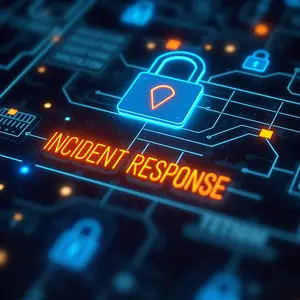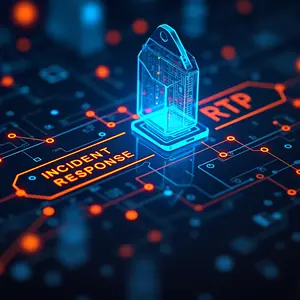Incident Response
Comprehensive incident response services: planning, detection, analysis, containment, eradication, recovery, and post-incident activity. Get back to business quickly.
What Is Incident Response and Why Is It Essential?
Incident response (IR) is the structured process of detecting, analyzing, containing, and recovering from cybersecurity events that threaten digital assets. It’s not just a fire department for your network—it’s a crucial defense line. When an alarm goes off, trained responders assess the threat, isolate the blaze, extinguish it, and investigate its cause to prevent future outbreaks. An IR plan isn’t just about reacting to threats; it’s about readiness, coordination, and decisive action under pressure. The stakes are high: according to IBM’s 2023 Cost of a Data Breach Report, companies without a tested IR plan spent $2.66 million more per breach than those with one. Moreover, 77% of organizations experienced at least one cybersecurity incident last year, while only 43% had a dedicated IR team. A common misconception is that IR begins after an attack—it starts far before, through preparation, policy creation, and regular simulations. Consequently, having a robust IR plan transforms moments of chaos into opportunities for control.

How Do You Know When an Incident Has Occurred?
Identifying a cybersecurity incident requires more than just noticing odd behavior—it demands visibility, context, and real-time alerting. Detection systems like Security Information and Event Management (SIEM) platforms, such as Splunk or Sentinel, aggregate logs from firewalls, endpoints, and cloud services, correlating patterns to detect anomalies. Imagine your network as a city and the SIEM platform as a central control tower monitoring all intersections for unusual traffic spikes. For instance, a sudden surge of outbound traffic from a single workstation may signal a data exfiltration attempt. One organization, lacking proper SIEM configuration, failed to detect a breach for 46 days, after which time-sensitive data had already been sold on dark web forums. Conversely, after tuning their SIEM to flag unauthorized PowerShell executions and failed login attempts, they caught a similar attack within hours and triggered their IR workflow. Moreover, timely detection supports compliance requirements like HIPAA and PCI-DSS, which mandate immediate breach identification and reporting.
What Are the Stages of a Proper Incident Response Plan?
An effective IR plan follows six core stages: preparation, identification, containment, eradication, recovery, and post-incident analysis. Each phase is vital, much like the coordinated roles in a surgical procedure—rushing any step can lead to reinfection or deeper damage. Preparation includes defining roles, assembling a response team, and documenting communication protocols. Identification is about confirming that an incident has occurred. Containment strategies—such as network segmentation or isolating compromised devices—prevent lateral movement. Tools like CrowdStrike or Carbon Black remove malware or unauthorized access points during eradication. Recovery ensures that systems are restored and verified before returning to normal operations. Post-incident analysis captures lessons learned, updates playbooks, and ensures compliance with frameworks like NIST SP 800-61. Nevertheless, many organizations skip the final step, missing the opportunity to evolve. Accordingly, a cycle of continuous improvement is essential to strengthen future defenses.
How Do You Contain a Cyber Incident Quickly?
Rapid containment is critical to prevent attackers from spreading through the network. This might include revoking user credentials, disabling services, or isolating compromised endpoints. Imagine a virus spreading in a hospital—containment is like quarantining the infected patient to protect the rest of the ward. Technologies like endpoint detection and response (EDR) platforms—such as SentinelOne or Microsoft Defender for Endpoint—enable immediate isolation of infected devices and block malicious processes in real time. One retail company experienced a ransomware outbreak that encrypted servers within minutes. They lacked segmentation and centralized controls, allowing the infection to cascade across departments. Conversely, another company with network segmentation in place contained a similar threat within a single subnet, minimizing downtime to under three hours. Moreover, PCI-DSS Requirement 12.10.5 explicitly calls for timely containment to limit data exposure. Accordingly, investing in containment capabilities isn’t just strategic—it’s a compliance obligation.
How Is Malware Eradicated and Systems Restored?
Eradication involves identifying root causes and eliminating malicious code, backdoors, or unauthorized tools left behind by attackers. It’s not as simple as deleting a suspicious file—malware often embeds itself across registry keys, scheduled tasks, or cloud APIs. Teams use forensic tools like FTK Imager, Sysinternals, and Velociraptor to uncover hidden persistence mechanisms. Recovery must include verified restoration from clean, versioned backups—ideally stored offline or in immutable formats. A healthcare provider attempted to recover from ransomware using compromised backups, inadvertently restoring the infection. After implementing immutable storage and performing routine backup integrity checks, future incidents were resolved swiftly with zero reinfection. Moreover, their adherence to HIPAA’s Security Rule on data integrity ensured legal and operational resilience. Consequently, having both eradication and clean recovery tools in place is paramount for business continuity.

What Does a Post-Incident Review Involve?
Post-incident reviews are often overlooked, yet they’re essential to transforming incidents into learning opportunities. The review involves documenting what happened, evaluating the effectiveness of the response, identifying weaknesses, and updating IR playbooks. Picture a pilot debriefing after turbulence—without this, the crew can’t prepare better for the next flight. This phase often includes timeline reconstruction, log analysis, and stakeholder interviews. One organization discovered during a review that alerts had been routed to an outdated email address, delaying their initial response. By updating contact lists, improving escalation protocols, and retraining staff, they avoided similar missteps later. Moreover, regulatory frameworks such as ISO 27001 emphasize continuous improvement through post-incident reviews. Continuous improvement is not just about fixing what went wrong, but also about identifying what went right and finding ways to do it better. Accordingly, debriefs aren’t just technical exercises but opportunities to build a more resilient and responsive culture.
Who Should Be Involved in Incident Response?
An effective response team isn’t limited to IT—it must include legal, HR, public relations, and executive leadership. Each role brings unique insight and responsibilities: legal ensures compliance with breach disclosure laws, HR handles insider threats, and PR manages public communication. Think of the IR team as a multidisciplinary emergency crew—everyone must understand their role and work in sync under pressure. Executive leadership, in particular, plays a crucial role in incident response. They provide strategic direction, make key decisions, and ensure that the response aligns with the organization’s overall goals and values. One financial firm suffered a breach and mistakenly allowed an untrained employee to communicate with the media, causing panic and reputational harm. Conversely, another firm had a predefined communication protocol, enabling a calm, coordinated statement that maintained trust with clients and regulators. Moreover, PCI-DSS 12.10.1 requires clear IR assignments and contact lists for timely coordination. Accordingly, clarity of roles and cross-department readiness are key to successful response efforts.
How Do You Maintain an Incident Response Plan?
IR plans must evolve with technology, staffing changes, and emerging threats. Maintenance includes quarterly tabletop exercises, updates after major incidents, and reviews during compliance audits. It’s like maintaining a fire extinguisher—testing it only after a fire is too late. Simulation platforms like Cyberbit and Immersive Labs provide realistic training environments to validate technical and procedural readiness. One manufacturing company failed an audit after discovering its IR plan hadn’t been reviewed in two years. After partnering with a managed cybersecurity provider, they built a review calendar and automated documentation and aligned their plan with NIST CSF standards. Moreover, consistent testing ensured their team remained agile, responsive, and audit-ready. Consequently, the maintenance of an IR plan is as essential as the plan itself.
What Are the Long-Term Benefits of a Strong Incident Response Strategy?
Organizations with a mature IR strategy reduce dwell time, minimize recovery costs, and avoid repeat incidents. The 2023 IBM report found that businesses with a well-tested IR plan saved an average of $1.49 million per breach. Moreover, proactive IR practices boost cyber insurance eligibility and simplify compliance with frameworks like CMMC, GDPR, and SOX. Once plagued by recurring incidents, one SaaS provider implemented an automated IR orchestration platform. Their average response time dropped from 19 hours to under 40 minutes within a year. Employee confidence grew, audit scores improved, and customer churn decreased. Accordingly, incident response is more than a reaction tool—it’s a strategic pillar of modern business resilience.
Just Two of Our Awesome Client Reviews:
Dylan Szewczak:
⭐️⭐️⭐️⭐️⭐️
“When our systems went down due to malware, we had no plan. It was a complete mess. Reno Cyber IT Solutions stepped in, led the recovery, and helped us build a real incident response plan. Now, we not only feel prepared—we know we are. Their professionalism was unmatched.”
Margaret Dixon:
⭐️⭐️⭐️⭐️⭐️
“Our compliance audit flagged our lack of a response plan, and we were scrambling. Reno Cyber IT Solutions helped us pass the audit and trained our whole staff on responding to a real threat. Their team made it easy to understand and implement, which ultimately changed our entire approach to security.”
Don’t wait until a cyber incident forces your hand.
Contact Reno Cyber IT Solutions for a free consultation and see how we can help you build or refine your incident response plan.
👉 Learn more about our Reno-based Managed IT Services and how we protect what matters most.
👉 Let’s turn your next emergency into a prepared, professional response!
In the unfortunate event of a cybersecurity incident, having a well-defined and rapidly executable incident response plan is critical to minimizing damage and ensuring business continuity. Incident response services provide the expertise and structured processes necessary to effectively detect, analyze, contain, eradicate, and recover from security breaches. This involves a skilled team ready to swiftly assess the situation, implement containment measures to prevent further spread, thoroughly investigate the root cause, and execute a recovery plan to restore normal operations as quickly as possible. A proactive approach to incident response can significantly reduce downtime, mitigate financial losses, and preserve the reputation of an organization.
Beyond the immediate response, comprehensive incident response services also include post-incident analysis to identify lessons learned and improve future security measures. This involves documenting the incident, reviewing the effectiveness of the response, and implementing preventative controls to reduce the likelihood of recurrence. Furthermore, these services often include the development of incident response plans tailored to the specific needs and risks of the organization, ensuring that everyone knows their roles and responsibilities in the event of a security event. By having a robust incident response capability in place, businesses can move from a reactive stance to a proactive one, building resilience and minimizing the long-term impact of cyber incidents.
Ready to Secure and Support Your Business?
Your Reliable, Compliant, and Secure IT Partner:
Ready to Support and Secure Your Business Every Step of the Way.
